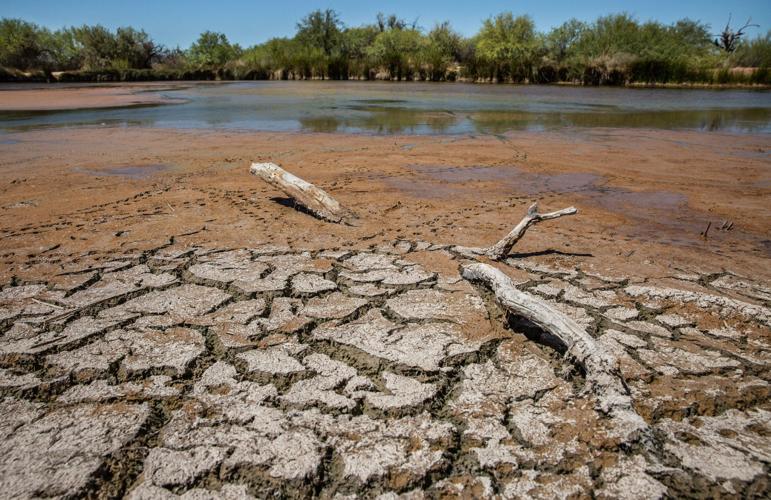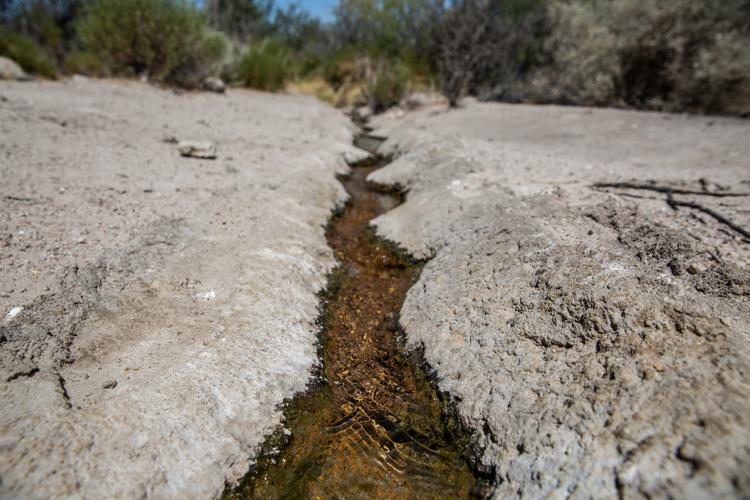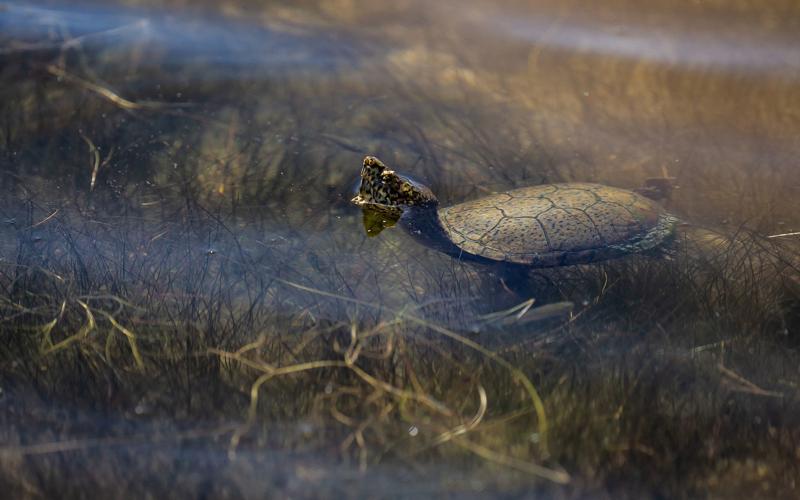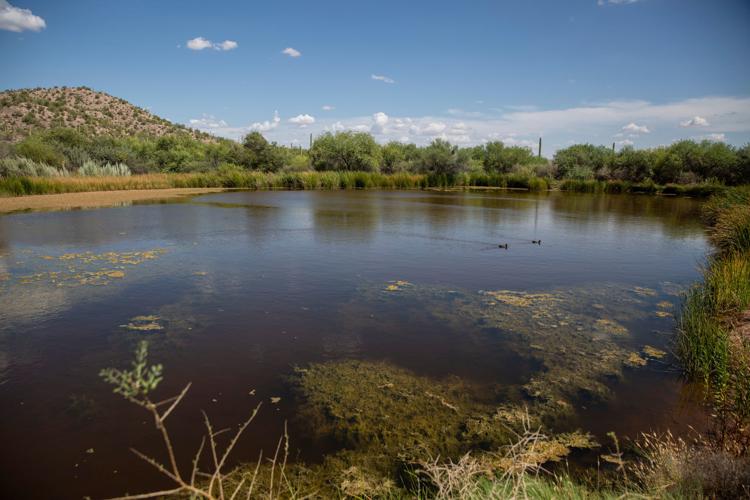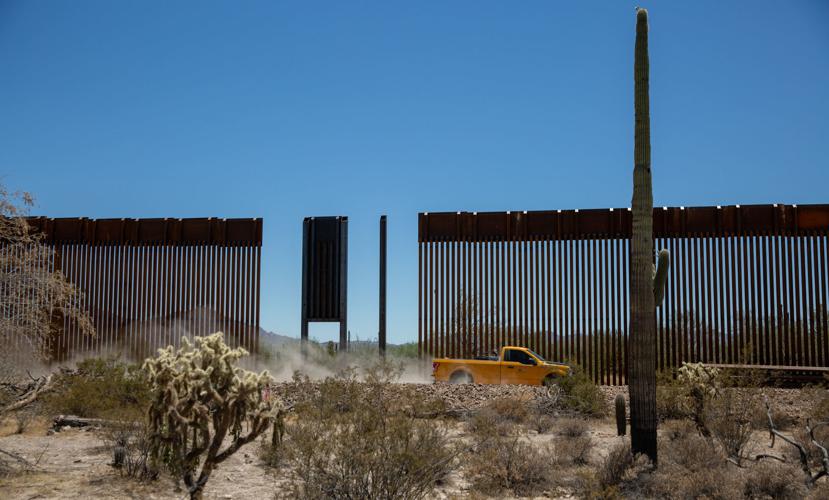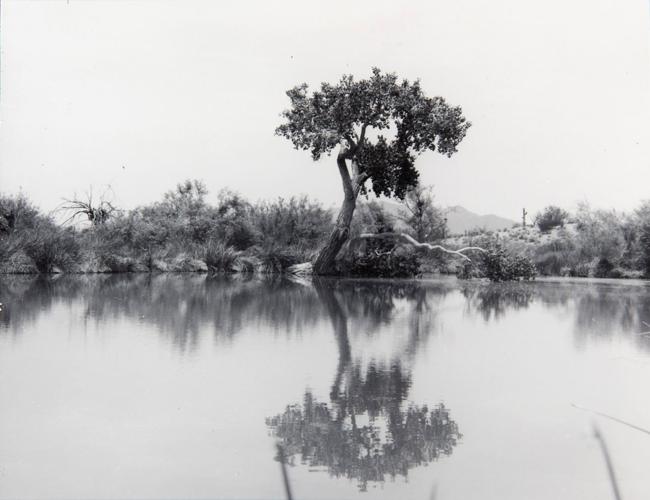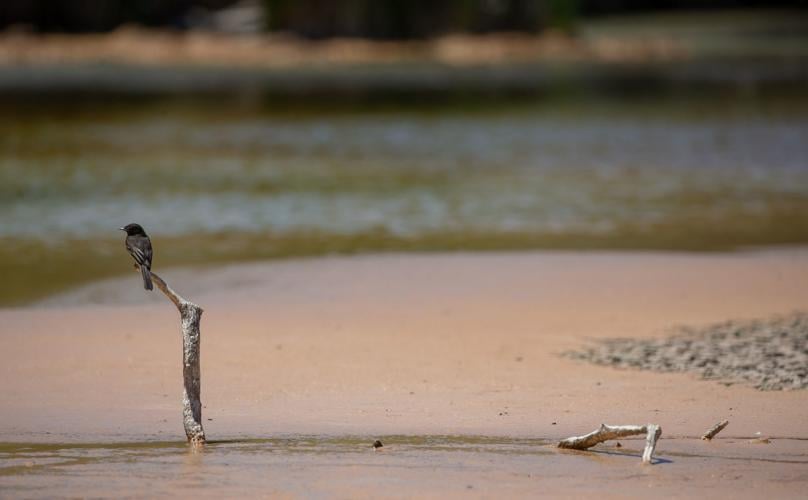A rare watering hole is starting to dry up in the desert southwest of ĂŰčÖÖ±˛Ą, raising concerns about the impact of nearby border wall construction on the aquifer.
Where ducks once paddled and dipped their beaks into the cool, turquoise waters of the pond at Quitobaquito Springs, large mud flats covered much of the north side of the pond on Tuesday. A few months ago, several feet of water covered the base of reeds that line the north end of the pond. Now some reeds stand on blocks of dirt surrounded by cracked mud or inches of water.
Environmental advocates worry the drop in water levels at the pond is the result of contractors building a 30-foot-tall border wall nearby, which involves pulling water from the aquifer and operating heavy machinery that could worsen cracks in the pond’s clay liner.
Experts caution the cause of the drop likely is more complicated. They didn’t rule out the impact of wall construction, but they also pointed to a decadeslong drop in water flow from the springs to the pond, farmers in nearby Sonoyta, Mexico, pulling water from the aquifer for their crops, and hot summer weather.
People are also reading…
“The situation is definitely alarming because there have only been a couple other times in the last 60 years that the pond has dropped this low,” said Michael Bogan, assistant professor in the School of Natural Resources and the Environment at the University of ĂŰčÖÖ±˛Ą.
For the past four years, Bogan has studied how populations of the endangered Sonoyta pupfish and mud turtles at Quitobaquito Springs fluctuate through time. He has not gone out to see the recent drop in water levels at the pond, but he saw photos provided by the Star and others circulating on social media.
Water levels at the pond rise and fall depending on the season, including a typical drop of 6 to 12 inches during the summer, Bogan said, but seasonal variations don’t explain the recent drop in water level.
“Even in the hottest times of the last four years, they didn’t drop enough to expose those mud flats,” Bogan said.

This picture from late August 2019 shows a much fuller pond at Quitobaquito Springs.
The pond is fed by a spring that emerges from a fissure in the granite rock north of the pond, as well as rainwater. On Tuesday, water still flowed down a concrete channel from the spring to the pond, but National Park Service gauges show the flow is decreasing.
For now, hydrologists with the park service are “closely monitoring” water levels at Quitobaquito Springs, said spokeswoman Vanessa Lacayo.

A Sonoyta mud turtle swims in the pond west of Lukeville. This species of turtle is found only in bodies of water within the Sonoran Desert.
“Water tables at the Quitobaquito Springs rely on and are impacted by several factors,” Lacayo said. “Our approach moving forward will be to review what those factors are to determine what steps can be made to support a healthy ecosystem and water flow.”
Last winter, the park service began a series of studies on the hydrology of the springs system, which included installing a real-time stream gauge, Lacayo said. In the following months, the gauges showed the flow from the spring continued to decrease, as it has done since the 1970s.
“That decrease, coupled with hot June temperatures, caused the pond water level to drop low enough to expose mud flats,” Lacayo said.
The springs hold a special place in the human history of Southern ĂŰčÖÖ±˛Ą and Sonora, according to park service archives. For centuries, travelers depended on the springs as the only year-round source of water for miles around. The springs are sacred to the Tohono O’odham Nation, whose ancestral lands include the springs.
The pond was built in the 1860s when a small community lived nearby. The pond and springs became part of Organ Pipe Cactus National Monument in the 1950s when the park service bought the land from a Hia C-ed O’odham family that had lived there since the 1880s.
The pond has a clay liner and earthen embankment, which require continuous upkeep, Lacayo said. The last time major work was done on the pond was 1962.

Quitobaquito Pond looking west in 1962.
The pond has sprung several leaks since 2006 that the park service continues to address, she said.
“We are working to determine where seepage is occurring,” Lacayo said, adding that work may be delayed due to the pandemic.
Lacayo referred questions related to the impact of border wall construction on the spring to Customs and Border Protection.
"While it is not unusual for water levels at Quitobaquito Springs to fluctuate, U.S. Customs and Border Protection is closely monitoring and coordinating with the National Park Service to look into the recent changes," the CBP public affairs office said in response to an inquiry from the Star.Â
On Tuesday, contractors had set up stacks of 30-foot-tall bollards along the border from Lukeville to a few miles from the springs. The wall itself now extends for about 5 miles west of Lukeville, or about seven miles east of Quitobaquito Springs.

A specialized segment of border wall in Organ Pipe National Monument west of Lukeville, on June 30, 2020.
When the wall contracts were announced last year, environmental advocates and hydrologists at the UA worried the water needed to mix concrete and tamp down dust would deplete the aquifer that feeds Quitobaquito Springs. After objections from U.S. and wildlife officials, CBP officials agreed to not dig any wells closer than 5 miles from the springs.
Laiken Jordahl, borderlands campaigner for the ĂŰčÖÖ±˛Ą-based Center for Biological Diversity and an outspoken critic of the border wall, said he was “absolutely horrified” at the sight of the pond.
Jordahl regularly visits Quitobaquito Springs and said the low water levels were “not typical, even for a hot, dry summer.”
Jordahl said he suspects the lowered levels were caused by the continuous vibrations of nearby construction equipment cracking the liner of the pond, a trench recently dug to lay wire for wall lighting or water being pumped out of the aquifer.
Jordahl called for wall construction to pause until the cause of the water level decline is figured out.
“None of this would ever be happening without the waivers,” Jordahl said, referring to the Department of Homeland Security waiving numerous laws, including those designed to protect the environment, to speed up the border wall construction in ĂŰčÖÖ±˛Ą and other border states.
“It looks like Trump’s border wall continues to damage environmental treasures and sacred Native American sites like Quitobaquito Springs,” U.S. Rep. Raúl Grijalva, a Democrat whose district includes the springs, said in a statement to the Star.
“Whether it’s destroying Native American cultural heritage or damaging the habitats of endangered species, Trump’s wall has brought nothing but destruction to Southern ĂŰčÖÖ±˛Ą,” Grijalva said. “What’s happening in Organ Pipe is one of the many reasons why we should end wall construction once and for all.”
Kevin Dahl, ĂŰčÖÖ±˛Ą senior program manager for the National Parks Conservation Association, said the “prudent thing” would be to pause pumping water for wall construction.
Dahl said he was confident the park service was doing all it could to figure out why the water level was dropping.
In the meantime, Dahl said he was “crossing his fingers that the monsoons come sooner, rather than later.”
UPDATE: This story was updated with a statement from Customs and Border Protection.

A bird perches on a branch sticking out of a dry spot in Quitobaquito Springs in Organ Pipe National Monument west of Lukeville, on June 30, 2020.
Contact reporter Curt Prendergast at 573-4224 or cprendergast@tucson.com or on Twitter @CurtĂŰčÖÖ±˛ĄStar


